Exploring modulation shows us how we send information over distances and through different ways. This important process changes basic signals to carry lots of data, like phone calls or satellite TV. Looking into its types, like Amplitude, Frequency, and Phase Modulation, shows us how each method deals with problems like noise and limited space for data.
Outline
Toggle- What Is Modulation?
- Advantages of Modulation:
- Different Types of Modulation
What Is Modulation?
Modulation is a technique in which message signal is transmitted to the receiver with the help of carrier signal. Here in modulation, we combine both carrier signal and message signal. You may get the doubt that what is the need of modulation. Just imagine that you have a paper which contains the message and you would like to send it to your friend standing 40 feet from your place. You can’t just through the paper to your friend because paper will not travel that much distance but if you take small stone and cover the paper with it and through it to your friend, it will definitely reach the target. In the same way, we need a carrier signal to transmit our message. Sometimes, message signal is also called as modulating signal. The exact definition of modulation is given below:
“Modulation is a process of message signal and modulating is varied according to the carrier signal for transmission purpose. The message signal can varied in accordance to the carrier signal that is in terms of angular or amplitude. So we are modulating the signal.”
Advantages of Modulation:
- With the help of modulation, we can increase the quality of reception.
- We can also decrease the height of the antenna.
- Avoid mixing of different frequency signals and increase the range of communication i.e. without modulation, we can transmit the message up to 100 meters and with modulation, we can transmit the message up to 150 meters.
- Allow the flexibility for adjusting the bandwidth.
In the definition, we have seen that message signal can be varied according to the angular or amplitude of the carrier signal. What happens if message signal is varied in accordance to angular of carrier signal and what happens if message signal is varied according to the amplitude of carrier signal?
Different Types of Modulation
Angle Modulation:
In the angle modulation, again there are two different types of modulations.
- Frequency modulation
- Phase modulation.
1. Frequency Modulation:
The process of carrier signal frequency is varied according to the message signal or modulation signal frequency by keeping the amplitude constant is called frequency modulation.
Advantages of Frequency Modulation:
- Frequency modulation has more noise resistivity when compared to other modulation techniques. That’s why they are mainly used in broadcasting and radio communications.
And we are all well aware that radio communication use mainly frequency modulation for transmission. We know that noise will occur mainly to the amplitude of the signal. In frequency modulation, amplitude is made constant and only frequency is varied, so we can easily find out the noise in the amplitude by using a limiter. - The frequency modulation is having greater resistance to rapid signal strength variation, which we will use in FM radios even while we are travelling and frequency modulation is also mainly used in mobile communication purposes.
- For transmitting messages in frequency modulation, it does not require special equipments like linear amplifiers or repeaters and transmission levels or higher when compared to other modulation techniques. It does not require any class C or B amplifiers for increasing the efficiency.
- Transmission rate is good for frequency modulation when compared to other modulation that is frequency modulation can transmit around 1200 to 2400 bits per second.
- Frequency modulation has a special effect called capture effect in which high frequency signal will capture the channel and discard the low frequency or weak signals from interference.
Disadvantages of Frequency Modulation:
- In the transmission section, we don’t need any special equipment but in the reception, we need more complicated demodulators for demodulating the carrier signal from message or modulating signal.
- Frequency modulation cannot be used to find out the speed and velocity of a moving object. Static interferences are more when compared to phase modulation. Outside interference is one of the biggest disadvantages in the frequency modulation. There may be mixing because of nearby radio stations, pagers, construction walkie-talkies etc.
- To limit the bandwidth in the frequency modulation, we use some filter which will again introduce some distortions in the signal.
- Transmitters and receiver should be in same channel and one free channel must be there between the systems.
- Spectrum space is limit for the frequency modulation and careful controlling the deviation ration.
Applications of Frequency Modulation (FM):
- Frequency modulation is used in radio’s which is very common in our daily life.
- Frequency modulation is used in audio frequencies to synthesize sound.
- For recording the video signals by VCR systems, frequency modulation is used for intermediate frequencies.
- Used in applications of magnetic tape storage.
2. Phase Modulation:
In the phase modulation, we vary the carrier signal in accordance with the phase of the modulating signal or message signal by keeping the frequency constant. If the amplitude of message or modulating signal is huge then the phase shift will also be greater.
Advantages and Disadvantages of Phase Modulation:
- The main advantage of phase modulation is that it has less interference from static, which is why we use this type of modulation in finding out the speed or velocity of a moving object. In frequency modulation, we cannot find out the velocity of moving object.
- The main disadvantage is phase ambiguity comes if we increase the phase modulation index, and data loss is more and we need special equipment like frequency multiplier for increasing the phase modulation index.
Applications of Phase Modulation:
- Phase modulation application is not different from frequency modulation. Phase modulation is also used in communication systems.
- It may be used in binary phase shift keying.
Amplitude Modulation:
In the amplitude modulation, amplitude of carrier signal wave is varied in accordance with the modulating or message signal by keeping the phase and frequency of the signals constant. The carrier signal frequency would be greater than the modulating signal frequency. Amplitude modulation is first type of modulation used for transmitting messages for long distances by the mankind. The AM radio ranges in between 535 to 1705 kHz which is great. But when compared to frequency modulation, the Amplitude modulation is weak, but still it is used for transmitting messages. Bandwidth of amplitude modulation should be twice the frequency of modulating signal or message signal. If the modulating signal frequency is 10 kHz then the Amplitude modulation frequency should be around 20 kHz. In AM radio broadcasting, the modulating signal or message signal is 15 kHz. Hence the AM modulated signal which is used for broadcasting should be 30 kHz.
Advantages of Amplitude Modulation:
- Because of amplitude modulation wavelength, AM signals can propagate longer distances.
- For amplitude modulation, we use simple and low cost circuit; we don’t need any special equipment and complex circuits that are used in frequency modulation.
- The Amplitude modulation receiver will be wider when compared to the FM receiver. Because, atmospheric propagation is good for amplitude modulated signals.
- Bandwidths limit is also big advantage for Amplitude modulation, which doesn’t have in frequency modulation.
- Transmitter and receiver are simple in Amplitude modulation. When we take a demodulation unit of AM receiver, it consists of RC filter and a diode which will demodulate the message signal or modulating signal from modulated AM signal, which is unlike in Frequency modulation.
- Zero crossing in Amplitude modulation is equidistant.
Disadvantages of Amplitude Modulation:
- Adding of noise for amplitude modulated signal will be more when compared to frequency modulated signals. Data loss is also more in amplitude modulation due to noise addition. Demodulators cannot reproduce the exact message signal or modulating signal due to noise.
- More power is required during modulation because Amplitude modulated signal frequency should be double than modulating signal or message signal frequency. Due to this reason more power is required for amplitude modulation.
- Sidebands are also transmitted during the transmission of carrier signal. More chances of getting different signal interfaces and adding of noise is more when compared to frequency modulation. Noise addition and signal interferences are less for frequency modulation. That is why Amplitude modulation is not used for broadcasting songs or music.
Applications of Amplitude Modulation:
- Used to carry message signals in early telephone lines.
- Used to transmit Morse code using radio and other communication systems.
- Used in Navy and Aviation for communications as AM signals can travel longer distances.
- Widely used in amateur radio.
All the above modulation will come under continuous wave modulation, where we will use a sine wave as carrier signal. Continuous wave modulation can be used in for both digital and analog communications.
When we take the pulse digital modulation, we use a periodic sequence of rectangular pulses as the carrier signal. Pulse digital modulation is also used in both analog and digital communications.
Types of Modulation:
In pulse width modulation, there are different types of modulation for analog and digital as shown below:
- PCM: Pulse Code Modulation for Analog Modulation.
- PPM: Pulse Position Modulation for Digital Modulation
- PDM: Pulse Duration Modulation for Digital Modulation.
- PAM: Pulse Amplitude Modulation for Digital Modulation.
Types of Modulation – Tree Diagram:
1. Pulse Code Modulation (PCM):
Pulse Code Modulation is first introduced by Alec Reeves in the year 1937. In the pulse code modulation, Analog Signal is reconstructed to digital signal for ease of transmission by using the analog signal samples. In technical terms, PCM will transmit the analog in a digital from, whose signal is sampled at regular intervals of time and quantized at same quantum levels to digital code. We know that digital code is nothing but binary code which consists of 1’s and 0’s that is logic1 and logic0. So we will transmit the digital data in the form of 1’s and 0’s. When the signal is received by the receiver, demodulator in the receiver will demodulate the binary signal back into pulses with same quantum levels like in modulator and these pulses are again used for regenerating the required analog signal.
Advantages of Pulse Code Modulation:
- Pulse code modulation will have low noise addition and data loss is also very low.
- We can repeat the exact transmitted signal at the receiver. This is called repeatability. And we can retransmit the signal with any distortion loss also.
- Pulse code modulation is used in music play back CD’s and also used in DVD for data storing whose sampling rate is bit higher.
- Pulse code modulation can be used in storing the data.
- PCM can encode the data also.
- Multiplexing of signals can also be done using pulse code modulation. Multiplexing is nothing for adding the different signals and transmitting the signal at same time.
- Pulse code modulation requires large bandwidth
- Pulse code modulation permits the use of pulse regeneration.
Disadvantages of Pulse Code Modulation:
- Specialized circuitry is required for transmitting and also for quantizing the samples at same quantized levels. We can do encoding using pulse code modulation but we need to have complex and special circuitry.
- Pulse code modulation receivers are cost effective when we compared to other modulation receivers.
- Developing pulse code modulation is bit complicated and checking the transmission quality is also difficult and takes more time.
- Large bandwidth is required for pulse code modulation when compared to bandwidth used by the normal analog signals to transmit message.
- Channel bandwidth should be more for digital encoding.
- PCM systems are complicated when compared to analog modulation methods and other systems.
- Decoding also needs special equipment’s and they are also too complex.
Applications of Pulse Code Modulation (PCM):
- Pulse code modulation is used in telecommunication systems, air traffic control systems etc.
- Pulse code modulation is used in compressing the data that is why it is used in storing data in optical disks like DVD, CDs etc. PCM is even used in the database management systems.
- Pulse code modulation is used in mobile phones, normal telephones etc.
- Remote controlled cars, planes, trains use pulse code modulations.
2. Pulse Amplitude Modulation (PAM):
In pulse amplitude modulation, the amplitude of regular interval of periodic pulses or electromagnetic pulses is varied in proposition to the sample of modulating signal or message signal. This is an analog type of modulation. In the pulse amplitude modulation, the message signal is sampled at regular periodic or time intervals and this each sample is made proportional to the magnitude of the message signal. These sample pulses can be transmitted directly using wired media or we can use a carrier signal for transmitting through wireless. There are two types of sampling techniques for transmitting messages using pulse amplitude modulation, they are
- FLAT TOP PAM: The amplitude of each pulse is directly proportional to instantaneous modulating signal amplitude at the time of pulse occurrence and then keeps the amplitude of the pulse for the rest of the half cycle.
- Natural PAM: The amplitude of each pulse is directly proportional to the instantaneous modulating signal amplitude at the time of pulse occurrence and then follows the amplitude of the modulating signal for the rest of the half cycle.
Flat top PAM is the best for transmission because we can easily remove the noise and we can also easily recognize the noise. When we compare the difference between the flat top PAM and natural PAM, flat top PAM principle of sampling uses sample and hold circuit. In natural principle of sampling, noise interference is minimum. But in flat top PAM noise interference maximum. Flat top PAM and natural PAM are practical and sampling rate satisfies the sampling criteria.
There are two types of pulse amplitude modulation based on signal polarity
- Single polarity pulse amplitude modulation
- Double polarity pulse amplitude modulation
In single polarity pulse amplitude modulation, there is fixed level of DC bias added to the message signal or modulating signal, so the output of modulating signal is always positive. In the double polarity pulse amplitude modulation, the output of modulating signal will have both positive and negative ends.
Advantages of Pulse Amplitude Modulation (PAM):
- It is the base for all digital modulation techniques and it is simple process for both modulation and demodulation technique.
- No complex circuitry is required for both transmission and reception. Transmitter and receiver circuitry is simple and easy to construct.
- PAM can generate other pulse modulation signals and can carry the message or information at same time.
Disadvantages of Pulse Amplitude Modulation (PAM):
- Bandwidth should be large for transmitting the pulse amplitude modulation signal. Due to Nyquist criteria also high bandwidth is required.
- The frequency varies according to the modulating signal or message signal. Due to these variations in the signal frequency, interferences will be there. So noise will be great. For PAM, noise immunity is less when compared to other modulation techniques. It is almost equal to amplitude modulation.
- Pulse amplitude signal varies, so power required for transmission will be more, peak power is also, even at receiving more power is required to receive the pulse amplitude signal.
Applications of Pulse Amplitude Modulation (PAM):
- It is mainly used in Ethernet which is type of computer network communication, we know that we can use Ethernet for connecting two systems and transfer data between the systems. Pulse amplitude modulation is used for Ethernet communications.
- It is also used for photo biology which is a study of photosynthesis.
- Used as electronic driver for LED lighting.
- Used in many micro controllers for generating the control signals etc.
3. Pulse Position Modulation (PPM):
In the pulse position modulation, the position of each pulse in a signal by taking the reference signal is varied according to the sample value of message or modulating signal instantaneously. In the pulse position modulation, width and amplitude is kept constant. It is a technique that uses pulses of the same breath and height but is displaced in time from some base position according to the amplitude of the signal at the time of sampling. The position of the pulse is 1:1 which is propositional to the width of the pulse and also propositional to the instantaneous amplitude of sampled modulating signal. The position of pulse position modulation is easy when compared to other modulation. It requires pulse width generator and monostable multivibrator.
Pulse width generator is used for generating pulse width modulation signal which will help to trigger the monostable multivibrator, here trial edge of the PWM signal is used for triggering the monostable multivibrator. After triggering the monostable multivibrator, PWM signal is converted into pulse position modulation signal. For demodulation, it requires reference pulse generator, flip-flop and pulse width modulation demodulator.
Advantages of Pulse Position Modulation (PPM):
- Pulse position modulation has low noise interference when compared to PAM because amplitude and width of the pulses are made constant during modulation.
- Noise removal and separation is very easy in pulse position modulation.
- Power usage is also very low when compared to other modulations due to constant pulse amplitude and width.
Disadvantages of Pulse Position Modulation (PPM):
- The synchronization between transmitter and receiver is required, which is not possible for every time and we need dedicated channel for it.
- Large bandwidth is required for transmission same as pulse amplitude modulation.
- Special equipments are required in this type of modulations.
Applications of Pulse Position Modulation (PPM):
- Used in non coherent detection where a receiver does not need any Phase lock loop for tracking the phase of the carrier.
- Used in radio frequency (RF) communication.
- Also used in contactless smart card, high frequency, RFID (radio frequency ID) tags and etc.
4. Pulse Duration Modulation (PDM) or Pulse Width Modulation (PWM):
It is a type of analog modulation. In pulse width modulation or pulse duration modulation, the width of the pulse carrier is varied in accordance with the sample values of message signal or modulating signal or modulating voltage. In pulse width modulation, the amplitude is made constant and width of pulse and position of pulse is made proportional to the amplitude of the signal. We can vary the pulse width in three ways
- By keeping the leading edge constant and vary the pulse width with respect to leading edge
- By keeping the tailing constant.
- By keeping the center of the pulse constant.
We can generate pulse width using different circuitry. In practical, we use 555 Timer which is the best way for generating the pulse width modulation signals. By configuring the 555 timer as monostable or astable multivibrator, we can generate the PWM signals. We can use PIC, 8051, AVR, ARM, etc. microcontrollers to generate the PWM signals. PWM signal generation has n number of ways. In demodulation, we need PWM detector and its related circuitry for demodulating the PWM signal.
Advantages of Pulse Width Modulation (PWM):
- As like pulse position modulation, noise interference is less due to amplitude has been made constant.
- Signal can be separated very easily at demodulation and noise can also be separated easily.
- Synchronization between transmitter and receiver is not required unlike pulse position modulation.
Disadvantages of Pulse Width Modulation (PWM):
- Power will be variable because of varying in width of pulse. Transmitter can handle the power even for maximum width of the pulse.
- Bandwidth should be large to use in communication, should be huge even when compared to the pulse amplitude modulation.
Applications of Pulse Width Modulation (PWM):
- PWM is used in telecommunication systems.
- PWM can be used to control the amount of power delivered to a load without incurring the losses. So, this can be used in power delivering systems.
- Audio effects and amplifications purposes also used.
- PWM signals are used to control the speed of the robot by controlling the motors.
- PWM is also used in robotics.
- Embedded applications.
- Analog and digital applications etc.

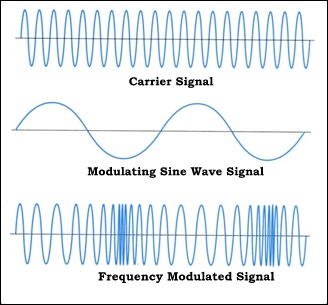
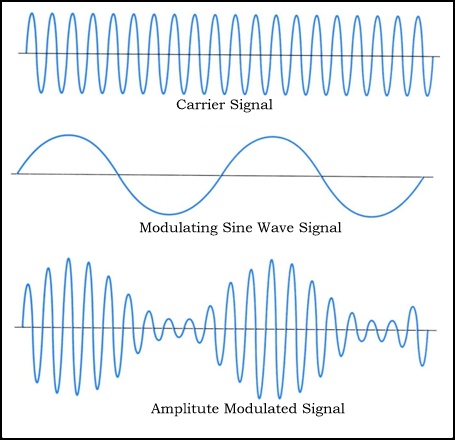
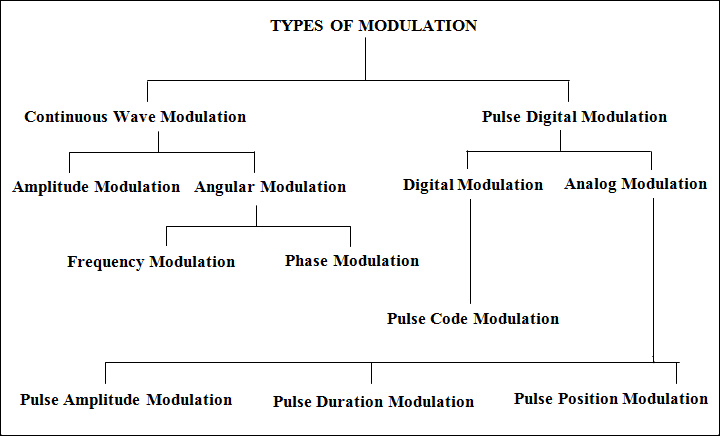
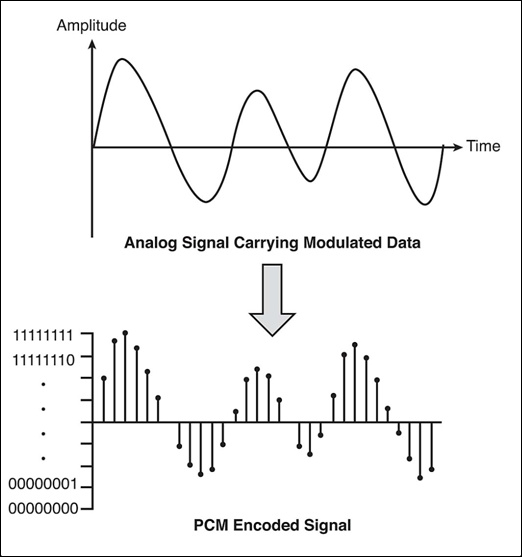
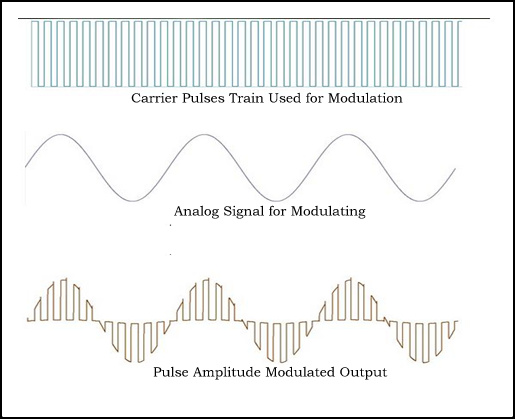

7 Responses
is the figure for frequency modulation correct? i just confused because what i have seen is that frequency will be high if the amplitude is high and vice versa butt in this figure it is just opposite…. help me please….
Yes you are the right I m also got confused if u have a answer than pls reply me
yea u r right…it’s a wrong figure shown here
Excellent…
Hello ~ Awesome article ~ Thank You
Actual definition of modulation is changing the characteristics (amplitude,frequency,phase) of a carrier signal according to characteristics of message signal.
Message signal should be the same, that transmitted from source to destination. That is the purpose of communication.
Some what useful,PPM and PWM have no figures.some repititions are there.